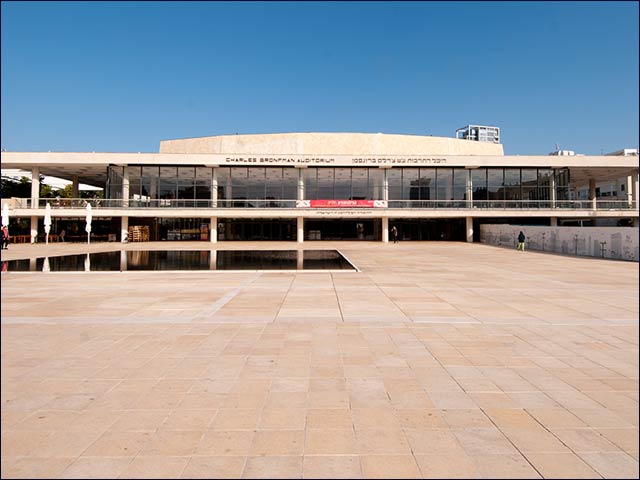When reflecting on exemplary Israeli architecture, most people would probably think of the spate of high-rise residential and office buildings that have been built here in recent years or are currently in the planning and development stage. Fueled by Israel’s high-tech industries, these projects are changing the skyline in many Israeli cities, but predominantly in Tel Aviv and its environs, where many leading local and international firms maintain their headquarters.
But due to Israel’s wealth of elegantly executed modernistic architecture, it is little wonder that this is not the consensus of many leading Israeli architects.
The January 2015 edition of
Wallpaper, the prestigious British architecture, design and lifestyle magazine, includes a special supplement focusing on Israeli creativity in design, architecture and style, produced in association with high-end Israeli quartz surface manufacturer
Caesarstone.
Prior to publication, the editors
interviewed 31 leading Israeli architects and asked them to rank their favorite buildings in Israel. Only three of the six most popular buildings chosen by the architects interviewed by the magazine are in Tel Aviv itself, with the others scattered around the country. Given the strength of the high-tech industry in recent decades, it was surprising to note that none of the most favored buildings was built in this century.
The building that ranked highest on the list was the old wing of the Tel Aviv Museum of Art. Designed by designed by Dan Eytan and Yitzchak Yashar, the main wing is a very respectful brutalist concrete structure built in early 1971. Brutalist architecture is an architectural movement popular in the mid-20th century that descended from the modernist architectural movement of the early 20th century. The term was coined by the famous French architect Le Corbusier to denote raw concrete (béton brut) as his choice of material. The Museum’s main building is situated on Shaul Hamelech Boulevard. An additional wing, designed by American architect Preston Scott Cohen, was added in 2011. Despite its geometrically independent pose, the new wing integrates beautifully with the old wing and continues a legacy of innovative architecture that has made Tel Aviv a Bauhaus mecca since the 1920’s.
Another popular architectural gem is Weizmann House, which was designed in 1935 in keeping with the international style, but also as a characteristic and original work of renowned architect Erich Mendelsohn. The form of the structure is simple and is designed to exacting proportions, which are highlighted by the use of clean forms. The structure is organized around a cylindrical stairwell, half facing the courtyard of the house with a pool in its center.
 Weizmann House. Photo courtesy of Weizmann Institute of Science
Weizmann House. Photo courtesy of Weizmann Institute of Science Long recognized as an architectural masterpiece, Weizmann House was the home of the first President of Israel, Chaim Weizmann. Now incorporated into the Weizmann Institute of Science, the house was built atop a hill in Rehovot, allowing it a commanding view of the coastal plain, a primary consideration in planning of the house.
The Mivtachim sanitarium, built on the forested slopes of the Carmel mountain range overlooking the Mediterranean in Zichron Ya’akov, is also considered an architectural gem. Designed by architect Ya’akov Rechter in 1968 in the brutalist style, the sanitarium combines a design that is both a simple and complex, seemingly ‘crowning’ the mountain. The unique serpentine-shaped structure earned Rechter the prestigious Israel Prize for architecture in 1973.
 The Mivtachim sanitarium
The Mivtachim sanitarium Jerusalem’s Israel Museum was designed by architect Al Mansfeld in 1965. As an architect, Mansfeld practiced and invented his own language of international modernism for the region, of which the Israel Museum is perhaps the finest example. Replicating in modular modernism a design system that would relate to the way in which a Mediterranean village might grow organically on a mountaintop, the skyline created by the museum is similar to that of an Arab village. The great achievement of this architectural creation, perhaps, is the combination of modern perception of matter and space with a reference to place and history. Mansfeld and interior designer Dora Gad were awarded the Israel Prize for Architecture in 1966 for their design of the Museum.
The Charles Bronfman Auditorium (formerly the Frederick R. Mann Auditorium) designed by Ze’ev Rechter and Dov Carmi and inaugurated in 1957 is another of Israel’s iconic buildings. Considered one of the most important buildings built in Israel’s first decade of independence, the building’s bold and innovative qualities are still apparent 50 years after it was first constructed. The auditorium is the largest concert hall in Israel, and home to the Israel Philharmonic Orchestra.
 The Habima Square auditorium
The Habima Square auditoriumThe Ein Harod Museum of Art was originally established in the 1930’s by one of the kibbutz members as an art corner in a small wooden hut. The museum’s permanent building, inaugurated in 1948, was planned by architect Samuel Bickels. Acclaimed internationally, the museum is considered one of the earliest and prime examples of modernist museum architecture based on natural lighting. The design and construction of the museum took place in three major phases, allowing the architect to improve his design solutions to tame and control the intense light of the Jezreel Valley.
Other buildings of note chosen by the architects are: Beit Halochem, the rehabilitation center for disabled war veterans in Beer Sheba in the nonconformist style of architecture, Ron Arad’s Design Museum of Holon, a topographic structure made up of Cor-Ten steel ribbons, the Negev Monument commemorating the capture of Beer Sheva in the War of Independence made up of geometric raw concrete shapes that abstractly symbolize the war and the Weizmann Institute’s Koffler Accelerator, a concrete modernist-inspired building built in the 1975.